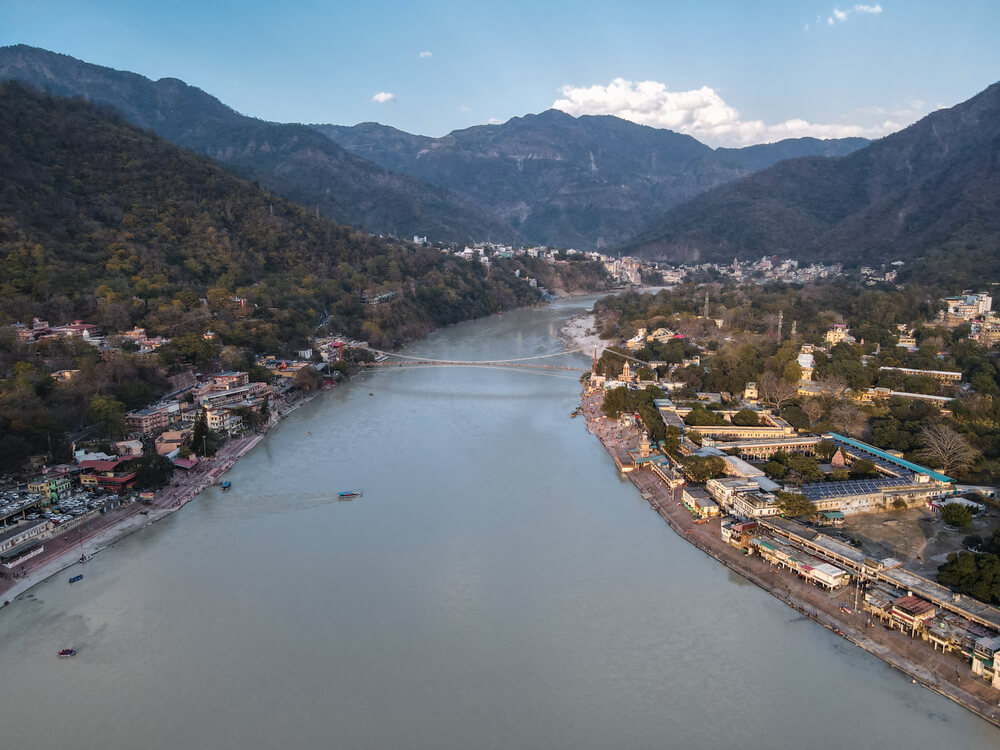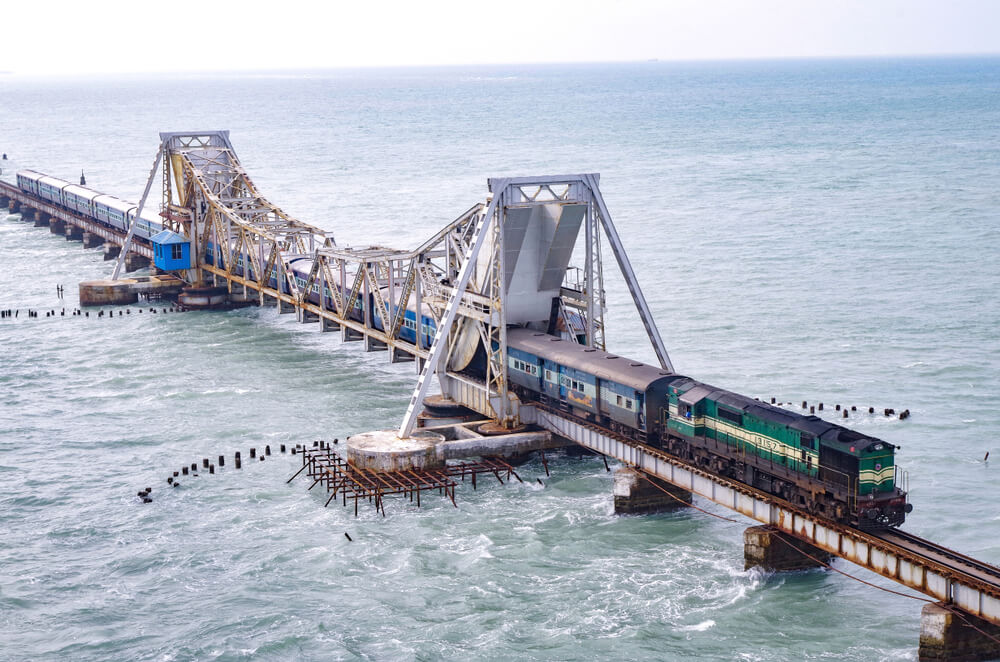Backstory | Proven Facts | Mythological Details | Mysterious Facts | Adam’s Bridge | Expedition | FAQ
If you have read Ramayana, you must know the story of the Ram Setu bridge which is also known as Adam’s bridge. It is a chain of limestone shoals that roughly connects India to Sri Lanka. This bridge has a massive mythological significance. There is a huge debate as to whether it is a naturally formed bridge or a manmade construction.
As per the mythological records, the bridge is manmade (technically made by apes). It was made to help Lord Ram’s army reach the shores of Sri Lanka where goddess Sita was held captive. There has been a lot of research on this aspect. Plenty of investigations were carried out from to time to ascertain the importance and significance of this bridge.
Here, we are going to check the different details and shed light on the various theories. The details will give you a clear picture of what to expect and what is the common consensus.
The Back Story
If you trace the books of history, you will find that there are few historical structures that blend history and mythology. The Ram Setu bridge happens to be one such construction.
Very recently, the central government ordered an underwater exploration for the sake of determining the age of this bridge. They wanted to learn more about the formation and trace its very root and history as well. Once this exploration will be over, a lot of details will be unearthed regarding whether or not this bridge dates back to the Ramayana period. There is also a lot of demand among people to call this setu a national monument as several religious sentiments are attached to it.
This bridge is a chain of natural mineral shoals. They are present between the Rameswaram island in Tamil Nadu and stretch all the way to Mannar islands in Sri Lanka. There is no denying the fact that even if it is a natural phenomenon, it is rather queer and very strange and something that confounds even the best of scientists and geologists as well.
The Proven Facts Of The Rama Setu Bridge
Here are some of the common facts that you need to know as far as the Rama Setu bridge is concerned.
The total length of this bridge is known to be approximately 50 km. This bridge separates the Gulf of Mannar from the Palk strait
As per the different scientific reports, the bridge was above sea level until 1480. Then a major cyclone hit the area that damaged this bridge. Even till the 15th century, people could walk on this bridge on foot but then the channel started to deepen and this created a deeper rift and now the bridge can’t be crossed over foot anymore.

Several geological reports have indicated that this bridge was a sort of land connection between India and Sri Lanka. The seawater here in the area is very shallow so it is almost impossible for ships to navigate in this region. This is the reason they need to take the longer roundabout route in order to reach Sri Lanka.
After several in-depth studies, it was concluded that the bridge is primarily made of limestone shoals and one can also spot a unique linear sequence of coral reefs along it. Also, investigations have concluded that it is made of several floating rocks across Rameswaram. There are scientific theories circulating that volcanic rocks are known to float on water so the floating stones are most likely to be volcanic in origin and thus they can float in water and don’t submerge underneath.
Oceanography research too was conducted and they suggest that the bridge is nearly 7000 years old. The carbon dating of beaches along Mannar Island and even Dhanushkodi too seem to prove the same thing. So, it is likely that the bridge is actually very old and has managed to somehow stay preserved.
A new project was proposed a long time back and it was known as the Sethusamudram project. The main aim of this project was to offer a shorter route from Pamban to Mannar island. But most environmentalists are of the opinion that should such a project kickstart, it will end up destroying the incredibly beautiful natural reefs that has been existing for several thousand years. This can also destroy the balance. However, as per the details sketched by the project, the bridge will be formed by deepening the Pamban pass. This will ensure that the Rama setu can still be preserved. However, the project was unable to start and continues to remain stalled even now.
The Books Of Mythology
There is no denying the fact that this bridge has a massive mythological significance. You will find its first mention in the books of Ramayana by Valmiki. As per the epic, it is believed that this bridge was built by the Vanar Sena. They were working to help Lord Rama find his wife, Goddess Sita, who was held captive in Sri Lanka by the then King Raavan.
The myth further states that the bridge was built with the help of floating stones. The stones could float as the Vanar Sena wrote the name of God Rama over them. This made the stones unsinkable and allowed them to float on water. They kept on adding these stones and it allowed them to make a bridge to Sri Lanka.
Ramayana is a massive epic and there are several references. The Rama setu, the Nala setu and the Setu Banda are the only three archaeological and historical pieces of evidence that somewhat proves that Ramayana did happen and that it is not a made-up story.
Some Mysterious Facts
The bridge is surely surrounded by a lot of mystery and has often been the talking point now and then.
The carbon dating at the beaches and the oceanographic studies pinpoint a time frame that is suggestive of the same time when the Ramayana epic seems to have happened. This has significantly sustained the claim that the setu was man-made by God’s army.
The bridge is also called Nala setu as Nala was the name of the architect who designed this bridge in the Ramayana epic. He had formulated the whole plan of making the bridge and writing the name of the lord to ensure they could have a bridge all over the ocean.
A lot of geologists strongly believe that such a structure cannot be manmade. There are a lot of discrepancies if you try to piece the epic and the exact location of the bridge. However, devotees argue that changes happened over a course of time but the bridge was indeed constructed by God himself and its existence in the current times is proof of the same thing. They, therefore, object to any construction of a bridge over the Rama setu as they consider it to be an impious thing to do and something sure to lead to more troubles.
Why Is The Ram Setu Bridge Also Known As Adam’s Bridge?
Several other references mention this bridge. The first-ever account of this bridge happened in Ibn Chordate’s Book of Roads and Kingdoms (c. 850). Here, it was referred to as Setu Bandha or the bridge of the sea.
A lot of other sources mentioned this bridge as Adams bridge as it is believed that he used this bridge to cross over from India to Sri Lanka. He did so after he was expelled from the Garden of Eden.
There is also an Abrahamic myth that states that Adam used this bridge for the sake of reaching a mountain that came to be known as Adam’s peak in Sri Lanka. It is also believed that here he stayed on one foot for close to 1000 years. This ensured that a hollow mark was left that resembled a footprint.
So, regardless of how true or false the theory is, the name has managed to stick and so those who don’t believe in the books of mythology choose to still call it Adam’s bridge.
The Expedition
The expedition was carried out in March 2021. A team of scientists along with archaeologists set out to explore the different limestone shoal chains that were present. They wanted to examine the nature of limestone rocks and the overall geological transformation that happened. They wanted to do in-depth research on the different features that were a part of the bridge.

Over the years, a lot of different proposals were sent to the Indian Council of Historical Research for the sake of an expedition for the Rama Setu. However, they didn’t manage to get any approval. Finally, a proposal has been accepted and the right funding was received as well. The key purpose of this expedition is to try to decipher whether or not the structure is manmade and thereby put an end to the yearlong mythological debacle that has been ongoing.
The ASI Updates
Back in 2007, the Archaeological Survey of India had commented that the Ram setu bridge was a natural formation and there was no account of it being man-made. The government of India filed an affidavit in the supreme court and mentioned that there was no proof whatsoever of the structure being a part of Ramayana.
However, in 2021, the central advisory board of archaeology approved a proposal for the detailed exploration of how and when exactly was the Rama Setu formed. This research has kickstarted this year and it is being conducted by the Council for Science and Industrial Research along with the National Institute of Oceanography.
Samples of sediments located as low as 35 to 40 metres below sea level are excavated and are being studied to determine the geological time scale. The latest radiometric technique too will be put to use. It is believed that it is coral and pumice stones are present. Corals contain calcium carbonate that can be put through the carbon dating process for the sake of determining the age of the bridge.
Bollywood And Bridge
Recently, Akshay Kumar starrer Ram Setu hit the theatres. The movie is all about the detailed exploration of the bridge. It wants to capture the buzz and interest that is already generated around the mythological debacle over the bridge.
A Rama Setu campaign too was held in order to ask people to save this bridge. Some people have very strong sentiments attached to the bridge. They believe it is proof of the existence of god. Therefore, they do not want any sort of deconstruction of further construction activity around the bridge. The fear that it will harm or collapse the bridge is looming large over such bhaktas.
Hindus don’t need any proof as they are confident that this bridge was built during the Ramayana phase. They believe it was used by the vanar sena to cross the ocean. So, any work on this bridge is likely to irk the whole section of people.
FAQ
What is the length of the Ram Setu bridge?
The Rama Setu set bridge is nearly 48 km long
Can you visit ram setu bridge?
Yes, visitors can take a van from Dhanush Kodi and visit the site. They will be able to see the floating stones used to make the bridge.
What is ram setu bridge also called?
Ram setu is also called Setu band, Adam’s bridge and even Nala setu.
Can you walk on the ram setu bridge?
As the water here is very shallow, you can walk on it for some distance but not too far.
